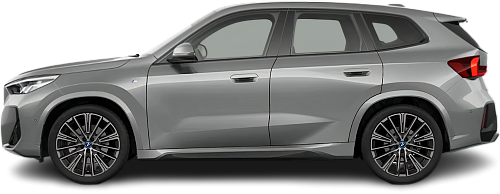USA EV Comparison: Hyundai Ioniq 5 XRT vs BMW iX1 xDrive30
Struggling to Decide? Let AI Help!
Your AI Summary Is Ready!
General Info
Both vehicles are currently in production. The Hyundai Ioniq 5 XRT (2025-...) has a starting price of $55400, while the BMW iX1 xDrive30 (2022-…) is not sold in the United States.
The two vehicles share the same body style: SUV.
| Property | Hyundai Ioniq 5 XRT | BMW iX1 xDrive30 |
|---|---|---|
| Years of Production | 2025-… | 2022-… |
| Current Status | Produced | Produced |
| Country of Manufacture | Indonesia, Singapore, South Korea | Germany, India, China |
| Body Style | SUV | SUV |
| Market Availability | USA | EU |
| Price USA (New) | $55400 | - Price USA (New) |
| GCC Score | 6.6 | 6.4 |
Range and Efficiency
While the Hyundai Ioniq 5 XRT (2025-...) offers a longer real-world range and a bigger battery, it is less energy-efficient than the BMW iX1 xDrive30 (2022-…).
| Property | Hyundai Ioniq 5 XRT | BMW iX1 xDrive30 |
|---|---|---|
| Range (EPA) | 259 mi | - Range (EPA) |
| Range (WLTP) | - Range (WLTP) | 273 mi |
| Range (GCC) | 246 mi | 233 mi |
| Battery Capacity (Nominal) | 84 kWh | 66.5 kWh |
| Battery Capacity (Usable) | 80 kWh | 64.7 kWh |
| Efficiency per 100 mi | 32.5 kWh/100 mi | 27.8 kWh/100 mi |
| Efficiency per kWh | 3.08 mi/kWh | 3.6 mi/kWh |
| Range and Efficiency Score | 6.1 | 6.7 |
Charging
The Hyundai Ioniq 5 XRT (2025-...) features an advanced 800-volt architecture, whereas the BMW iX1 xDrive30 (2022-…) relies on a standard 400-volt system.
The Hyundai Ioniq 5 XRT (2025-...) offers faster charging speeds at DC stations, reaching up to 250 kW, while the BMW iX1 xDrive30 (2022-…) maxes out at 128 kW.
The BMW iX1 xDrive30 (2022-…) features a more powerful on-board charger, supporting a maximum AC charging power of 11 kW, whereas the Hyundai Ioniq 5 XRT (2025-...) is limited to 10.9 kW.
| Property | Hyundai Ioniq 5 XRT | BMW iX1 xDrive30 |
|---|---|---|
| Max Charging Power (AC) | 10.9 kW | 11 kW |
| Max Charging Power (DC) | 250 kW | 128 kW |
| Architecture | 800 V | 400 V |
| Charge Port | Tesla (NACS) | CCS Type 2 |
| Charging Score | 8 | 5.9 |
Performance
Both vehicles are all-wheel drive.
The Hyundai Ioniq 5 XRT (2025-...) boasts greater motor power and accelerates faster from 0 to 60 mph.
| Property | Hyundai Ioniq 5 XRT | BMW iX1 xDrive30 |
|---|---|---|
| Drive Type | AWD | AWD |
| Motor Type | PMSM (front), PMSM (rear) | PMSM (front), PMSM (rear) |
| Motor Power (kW) | 239 kW | 230 kW |
| Motor Power (hp) | 320 hp | 308 hp |
| Motor Torque | 446 lb-ft | 364 lb-ft |
| 0-60 mph | 5 s | 5.4 s |
| Top Speed | 115 mph | 112 mph |
| Performance Score | 5.2 | 4.8 |
Dimensions
The Hyundai Ioniq 5 XRT (2025-...) is longer and wider, but about the same height as the BMW iX1 xDrive30 (2022-…).
The Hyundai Ioniq 5 XRT (2025-...) boasts a more extended wheelbase.
| Property | Hyundai Ioniq 5 XRT | BMW iX1 xDrive30 |
|---|---|---|
| Length | 183.3 in | 177.2 in |
| Width (with Mirrors) | 84.7 in | 82.8 in |
| Width (w/o Mirrors) | 74.4 in | 72.6 in |
| Height | 64 in | 63.6 in |
| Wheelbase | 118.1 in | 106 in |
Cargo and Towing
The Hyundai Ioniq 5 XRT (2025-...) provides more cargo capacity, featuring both a larger trunk and more space with the rear seats folded.
A frunk (front trunk) is available in the Hyundai Ioniq 5 XRT (2025-...), but the BMW iX1 xDrive30 (2022-…) doesn’t have one.
The BMW iX1 xDrive30 (2022-…) has a towing capacity of up to 2645 lb, whereas the Hyundai Ioniq 5 XRT (2025-...) is not officially rated for towing in the US.
| Property | Hyundai Ioniq 5 XRT | BMW iX1 xDrive30 |
|---|---|---|
| Number of Seats | 5 | 5 |
| Curb Weight | 4707 lb | 4596 lb |
| Cargo Volume (Trunk) | 26.3 ft3 | 17.3 ft3 |
| Cargo Volume (Max) | 58.5 ft3 | 52.8 ft3 |
| Cargo Volume (Frunk) | 0.8 ft3 | - Cargo Volume (Frunk) |
| Towing Capacity | - Towing Capacity | 2645 lb |
| Cargo and Towing Score | 6.8 | 6.5 |




